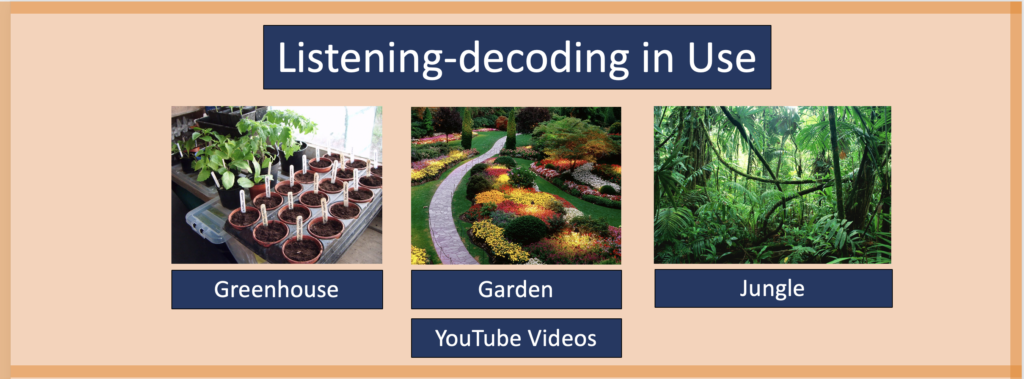Listening-decoding in Use

Videos of the 2020 workshop are available here
Handouts and sound files are available here
Rationale is below
Listening Decoding in Use – Proposal
Listening Decoding in Use will be a series of textbooks (Student Books for use in class and self-study) accompanied by recordings. There will be three General English levels (Elementary, Intermediate, Advanced) plus an ESOL and Academic versions: five versions in all.
Failings of Current Listening Methodology
Listening is the most poorly taught, and most poorly learned skill. Teachers are trained to ‘do things in the listening lesson’ but the things that they are trained to do – though useful in filling time – are not resulting in listening competence .
Grab Guess and Build
Current orthodoxy in the listening class can be characterized as a ‘Grab, Guess and Build’ methodology.
- Grab the stressed syllables
- Guess the remaining words
- Build meaning
The trouble is that this methodology is practising coping when you can’t catch what’s going on. Repeated practice in coping is not teaching and learning. We need to give students things to learn about the sound substance so that they can catch what’s going on as the sound substance of speech rushes past their ears.
There is something to teach, there is something to learn
The Listening Decoding in Use series aims to remedy the failings of the current methodology by providing a systematic approach to familiarizing students – and their teachers – with the fast messiness of normal speech. The principles are that:
- All words have multiple sound shapes of which the citation form is least likely to occur
- The natural state of a word is to be spoken in a stream of other words
- Speakers are the shapers of every word and every speech unit, not the language
- There are no certainties, or right ways, to speak normal speech
- There is something to teach, and something to learn
- Coping practice is inefficient, ineffective, and is an obstacle to learning
The units of Listening Decoding in Use cover the traditional list of speech sounds (vowels consonants) and shows how they can be dropped blurred or blended in the sound substance of normal speech. It also covers streamlining phenomena such as the hiss effect (it’s wonderful, becomes ‘wonderful), and polarisks (where can sounds like can’t and vice versa) and mondegreens.
Each unit would take between 15-20 minutes of class time – once teachers and students are familiar with the pattern of each unit.
Inspired by Phonology for Listening: Teaching the Stream of Speech and (even more so) by A Syllabus for Listening – Decoding, each level will contain 60 units each focusing on a decoding issue. By ‘decoding’ issues I mean (for example):
- consonant death – e.g. the /d/ in middle is dropped and becomes mill as in
|| IN the mill of the ROAD || - vowel play (foul play) – e.g. the diphthong |eɪ| in able becomes |e| – thus ebble
|| he’s NOT ebble to SEE you || - syllable drop – e.g. the three-syllable word everyone becomes two-syllable evun
|| evun always LIKES her ||
Contents page for the intermediate level, and a sample chapter is available. Email me richardcauldwell@me.com
